This article was medically reviewed by Sarah Gehrke, RN, MS and by wikiHow staff writer, Danielle Blinka, MA, MPA. Sarah Gehrke is a Registered Nurse and Licensed Massage Therapist in Texas. Sarah has over 10 years of experience teaching and practicing phlebotomy and intravenous (IV) therapy using physical, psychological, and emotional support. She received her Massage Therapist License from the Amarillo Massage Therapy Institute in 2008 and a M.S. in Nursing from the University of Phoenix in 2013.
There are 12 references cited in this article, which can be found at the bottom of the page.
wikiHow marks an article as reader-approved once it receives enough positive feedback. In this case, 92% of readers who voted found the article helpful, earning it our reader-approved status.
This article has been viewed 70,173 times.
Experiencing contractions too early in your pregnancy can be scary, but they don’t always mean that you’re in labor. You could be having Braxton-Hicks contractions, and if that's the case, there are measures you can take to ease your discomfort. If you have symptoms of preterm labor, though, you’ll want to take swift action, as they could cause your baby to be born prematurely. While preterm labor usually occurs in women who have a risky pregnancy, it can also happen in women with healthy pregnancies. If you’re worried you could go into preterm labor, call your doctor right away or head to the hospital.
Steps
Taking Immediate Steps to Stop Contractions
-
1Notify your doctor that you’re experiencing contractions. Your doctor will likely ask you to take steps to stop the contractions before coming in for a visit, depending on your pregnancy history. It’s common for women to feel early contractions that either stop or turn out to be false contractions. However, your doctor needs to know that you are experiencing these symptoms and may need care soon.[1]
- Say, “I think I’m having early contractions. What do you recommend?”
- Ask, “When should I go to the hospital?”
-
2Empty your bladder. A full bladder can put added pressure on your abdomen, so emptying it can help relieve the contractions.[2] Holding in your urine also inflames your bladder, which affects your uterus and can cause contractions.[3] Plus, it will help you get comfortable while you wait for further instructions from your doctor.Advertisement
-
3Lie down on your left side. Use pillows to prop up your right side, causing you to tilt to the left. Tilting to the left can help slow or stop contractions, so get comfortable on your bed or couch.[4]
- If you have someone who can help you, ask them to position the pillows and help you get comfortable.
- Try to relax to help your body stop the contractions. You can try listening to peaceful music or watching a distracting TV program or movie.[5]
-
4Avoid lying flat on your back, as this can encourage contractions. When lying down, you should always stay tilted to the side. Monitor the position of your pillows and ask for help with staying propped up if someone is with you. Lying on your back can worsen the contractions.[6]
- Your left side is the best option, though either side is better than your back.[7]
-
5Drink several glasses of water. Dehydration is sometimes to blame for early contractions, so drinking plenty of water can eliminate the problem. If possible, remain propped on your left side as you drink the fluids.[8]
- If someone is with you, ask them to refill your water glass so that you can keep drinking without having to get up.
-
6Avoid strenuous activity. Being too active can cause early contractions, but you may be able to stop them by getting adequate rest. If you feel contractions, immediately stop your activity.[9]
- Talk to your family, friends, and coworkers about reducing your activity load. For example, say to family, “I need help with house cleaning right now. I’m feeling contractions, so I need to rest.”
-
7Time your contractions for as long as they continue. Use a clock, watch, or timer to count the minutes between contractions. You should also time how long the contractions last.[10] True contractions will happen at regular intervals and last from 30 to 70 seconds. They will also occur regularly every 5 to 10 minutes over the course of an hour, so contact your doctor immediately if yours fit into this window.[11]
-
8Avoid smoking. Smoking is a common cause of early contractions, so stay away from cigarettes. Even if you’ve avoided them throughout your pregnancy, now is not the time to calm your nerves with a cigarette.[12]
-
9See a doctor if your contractions continue longer than an hour. Go to the hospital or contact your care provider immediately. This does not mean that you are in preterm labor, but you do need to get examined to make sure that it is just false labor and not something more.[13]
Recognizing Braxton-Hicks Contractions
-
1Notice if your contractions happen randomly or infrequently. While normal labor contractions will be regular and frequent, false labor contractions will happen at odd intervals and periodically. You may have several really long contractions that cause you to be concerned, but they do not mean you are in active labor.[14]
- For example, you may have regular pains for half an hour, but then have a break from the contractions.
- Alternatively, you may notice that your contractions are lasting for random amounts of time, such as a minute-long contraction followed by a 20 second long contraction.
-
2Time your contractions to see if they last from 15 to 30 seconds. While true labor contractions will last from 30 to 70 seconds, Braxton-Hicks contractions will vary in length, usually lasting from 15 to 30 seconds.[15] Some false contractions can even last as long as two minutes, which is an immediate sign that they are not true contractions.[16]
- True labor contractions will slowly progress toward sharper, well-timed contractions, while Braxton-Hicks contractions will continue to be sporadic.
-
3See if they stop when you rest or change position. Braxton-Hicks contractions will often stop if you rest, change position, or start to slowly walk around. However, true contractions will continue no matter what. If you’ve tried resting or changing positions and the contractions continue, contact your doctor immediately.[17]
-
4Notice if you’re feeling discomfort and tightening in your abdomen. Braxton-Hicks contractions are usually described as more uncomfortable than painful. You may feel your abdomen contracting and tightening without sharp pains.[18] True labor will be felt more in the lower back and will be painful.[19]
-
5Notice if you can feel your baby moving. During Braxton-Hicks contractions, you will still be able to feel your baby moving around, unlike with regular labor. While it can add to your discomfort, your baby’s movements are a sign that you aren’t having real contractions because you won’t feel your baby during real labor.[20]
Recognizing Preterm Labor
-
1Notice a painful tightening that has become regular and frequent. Watch for increasing regularity as your body progresses toward active labor. Feel your abdomen as the contractions occur to see if it’s widespread across your entire abdomen.[21]
- Real labor contractions will be painful rather than just uncomfortable.
-
2Count your contractions to see if you’ve reached five per hour. Fewer than five contractions in an hour should be monitored, but it’s not time for concern. However, five contractions in one hour can indicate active labor and requires immediate attention from a health care provider.[22]
-
3Watch for a low, dull backache. Real labor starts in your back, so you’ll feel more pain and discomfort in your lower back than in your stomach. Over time, the dull ache will be accompanied by shooting pains as contractions progress.[23]
-
4Check for a pressure in your abdomen or pelvis, coupled with cramps. As your body starts to go into labor, you’ll feel pressure in your lower abdomen, not just the pain that you may expect. You will also feel cramps similar to period cramps as your muscles start to contract and release.[24]
-
5Watch for spotting or bleeding. Spotting or bleeding can occur in underwear or on toilet paper. This type of discharge should be brought up with your medical provider immediately, especially if you are having other symptoms of preterm labor.[25]
-
6Notice watery vaginal discharge. Your water may start to break. With preterm labor, it could start to trickle out, or it may gush out if your water breaks all the way.
- You may also notice a change in vaginal discharge, such as a color change or a change in the amount of discharge.[26]
-
7Contact your doctor immediately if you have any symptoms. Don’t doubt yourself if you’re worried that you have symptoms of preterm labor. Visit your care provider as soon as possible. If you’re not in preterm labor, your doctor will be happy that you came in to get checked out. Remember, everyone wants the best for you and your baby.[27]
- Your doctor will conduct several tests to find out if you’re in preterm labor, including an ultrasound, pelvic exam, and lab tests. You will also undergo uterine monitoring so that the doctor can evaluate your contractions.
- The doctor may order an amniocentesis to determine if your baby’s lungs are well-developed or if there is an infection in the amniotic fluid.[28]
Treating Preterm Labor
-
1Get intravenous fluids to stay hydrated. Your doctor may be able to stop your contractions using intravenous fluids, especially if you’ve been dehydrated. You will need to contact your care provider for this treatment.[29]
-
2Try antibiotics if an infection caused your contractions. Some infections can trigger early labor, so your doctor may be able to treat the underlying condition and stop your labor. To prevent this type of complication, visit your doctor immediately if you suspect you are ill. Your illness could also be passed along to your baby, so follow your doctor’s care instructions.[30]
-
3Take tocolytics to potentially stop the contractions. Your doctor can prescribe tocolytics, which can stop contractions for up to two days. While they can’t completely stop preterm labor, they can help delay it, allowing you and your doctor more time to use other treatments. Tocolytics also allow you more time to move to another care facility that is better equipped to handle preterm labor and care for a premature baby.
- Your doctor likely won’t be able to use a tocolytic if you have complicating conditions, such as high blood pressure.[31]
-
4Get an injection of corticosteroids. While they won’t stop preterm labor, corticosteroids can speed up your baby’s lung development, making early delivery less risky. You will be given an injection of corticosteroids if you’re at risk of delivering between weeks 24 and 34. You may still receive them during weeks 34 and 36 if your doctor thinks you will deliver within the week, and you haven’t previously received the drugs.[32]
-
5Use magnesium sulfate. Like corticosteroids, magnesium sulfate will help you deliver more safely. This treatment will help babies born between weeks 24 and 32 avoid conditions that can occur in preterm babies.[33]
- Magnesium sulfate will be administered by injection. Your doctor will have to order a prescription, so ask your doctor if they recommend it in your case.[34]
- This medication is most often administered to women who have already been admitted to the hospital with preterm labor.
References
- ↑ http://americanpregnancy.org/labor-and-birth/premature-labor/
- ↑ http://americanpregnancy.org/labor-and-birth/premature-labor/
- ↑ https://www.whattoexpect.com/pregnancy/preterm-labor/
- ↑ http://americanpregnancy.org/labor-and-birth/premature-labor/
- ↑ http://www.mayoclinic.org/diseases-conditions/preterm-labor/basics/lifestyle-home-remedies/con-20035359
- ↑ http://americanpregnancy.org/labor-and-birth/premature-labor/
- ↑ http://americanpregnancy.org/pregnancy-health/sleeping-positions-during-pregnancy/
- ↑ http://americanpregnancy.org/labor-and-birth/premature-labor/
- ↑ http://www.mayoclinic.org/diseases-conditions/preterm-labor/basics/lifestyle-home-remedies/con-20035359
- ↑ http://americanpregnancy.org/labor-and-birth/premature-labor/
- ↑ http://www.mayoclinic.org/healthy-lifestyle/labor-and-delivery/in-depth/signs-of-labor/art-20046184?pg=2
- ↑ https://www.whattoexpect.com/pregnancy/preterm-labor/
- ↑ http://americanpregnancy.org/labor-and-birth/premature-labor/
- ↑ http://americanpregnancy.org/labor-and-birth/braxton-hicks/
- ↑ http://www.mayoclinic.org/healthy-lifestyle/labor-and-delivery/in-depth/signs-of-labor/art-20046184?pg=2
- ↑ http://americanpregnancy.org/labor-and-birth/braxton-hicks/
- ↑ http://www.mayoclinic.org/healthy-lifestyle/labor-and-delivery/in-depth/signs-of-labor/art-20046184?pg=2
- ↑ http://www.webmd.com/baby/guide/true-false-labor#1
- ↑ https://www.whattoexpect.com/pregnancy/false-labor
- ↑ https://www.whattoexpect.com/pregnancy/false-labor
- ↑ http://www.mayoclinic.org/diseases-conditions/preterm-labor/basics/symptoms/con-20035359
- ↑ http://americanpregnancy.org/labor-and-birth/premature-labor/
- ↑ http://www.mayoclinic.org/diseases-conditions/preterm-labor/basics/symptoms/con-20035359
- ↑ http://www.mayoclinic.org/diseases-conditions/preterm-labor/basics/symptoms/con-20035359
- ↑ http://www.mayoclinic.org/diseases-conditions/preterm-labor/basics/symptoms/con-20035359
- ↑ http://www.mayoclinic.org/diseases-conditions/preterm-labor/basics/symptoms/con-20035359
- ↑ http://www.mayoclinic.org/diseases-conditions/preterm-labor/basics/symptoms/con-20035359
- ↑ http://www.mayoclinic.org/diseases-conditions/preterm-labor/basics/tests-diagnosis/con-20035359
- ↑ https://www.whattoexpect.com/pregnancy/preterm-labor/
- ↑ https://www.whattoexpect.com/pregnancy/preterm-labor/
- ↑ http://www.mayoclinic.org/diseases-conditions/preterm-labor/basics/treatment/con-20035359
- ↑ http://www.mayoclinic.org/diseases-conditions/preterm-labor/basics/treatment/con-20035359
- ↑ http://www.mayoclinic.org/diseases-conditions/preterm-labor/basics/treatment/con-20035359
- ↑ https://www.acog.org/Resources-And-Publications/Committee-Opinions/Committee-on-Obstetric-Practice/Magnesium-Sulfate-Use-in-Obstetrics
About This Article
To stop contractions, try going to the bathroom to relieve yourself, since a full bladder can put pressure on your uterus, which can result in contractions. You can also lie down on your left side and use pillows to prop yourself up, since tilting to the left can help slow contractions. Additionally, drink a few glasses of water to avoid dehydration, which often makes contractions worse. If your contractions start to occur every 5 to 10 minutes or last over an hour, contact your doctor to see if you should go in for an examination. For advice from our Medical co-author on how to tell the difference between Braxton-Hicks contractions and pre-term labor, read on.
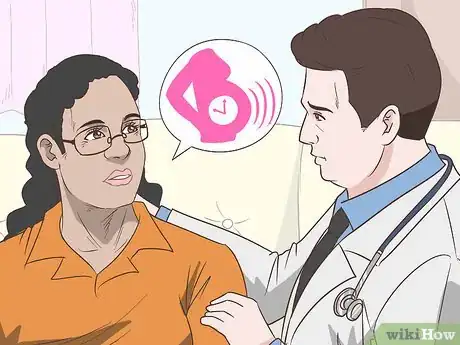
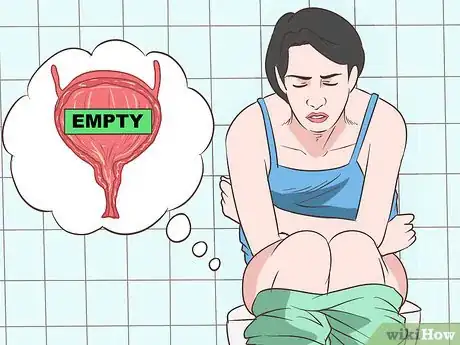

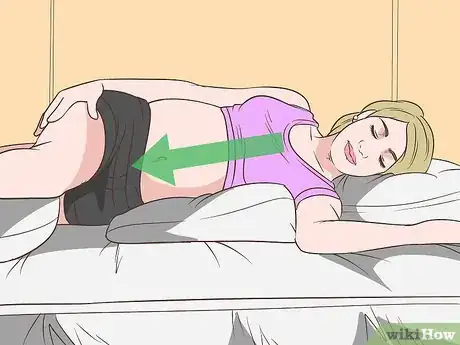
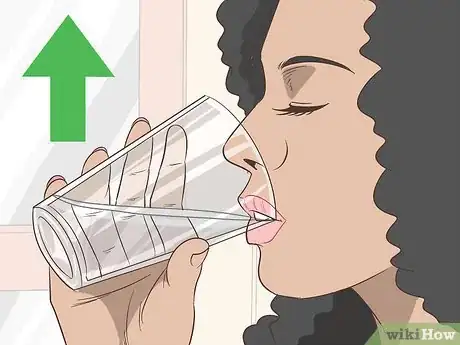
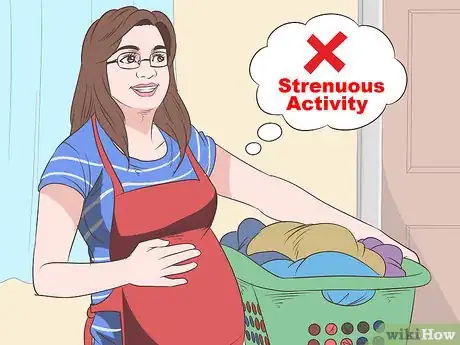
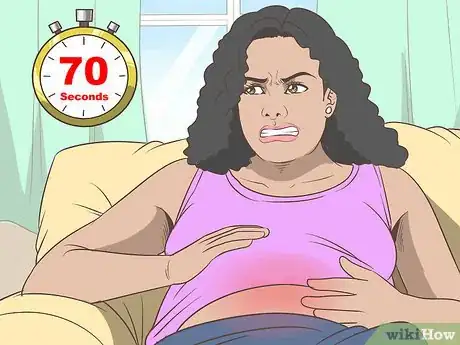

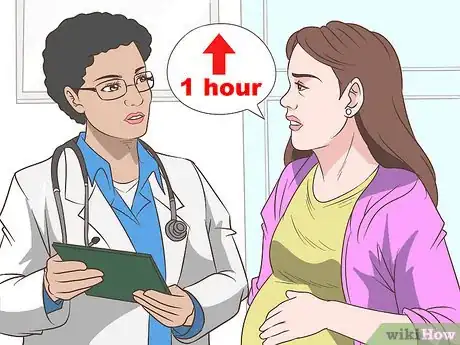

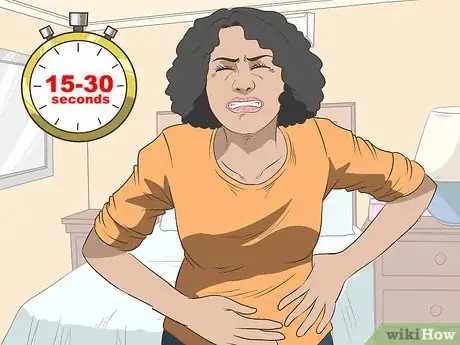
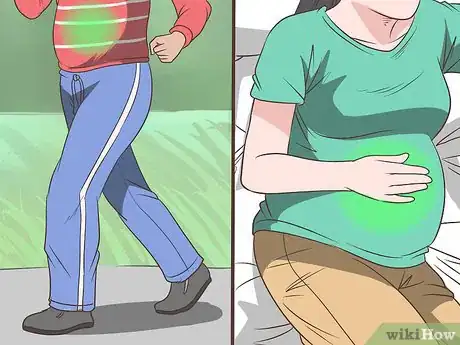

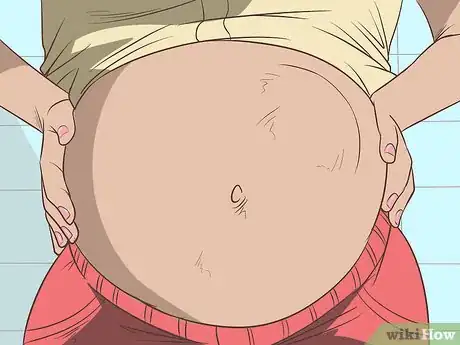

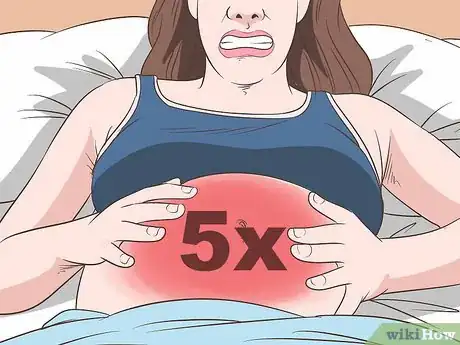
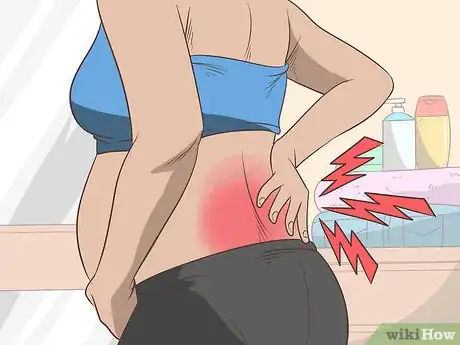
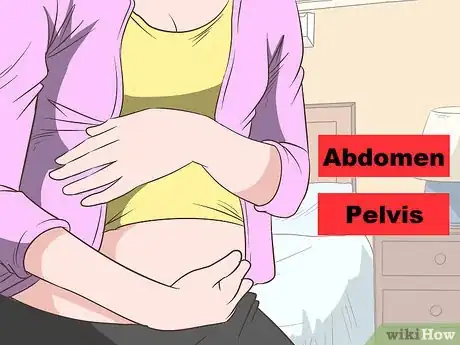
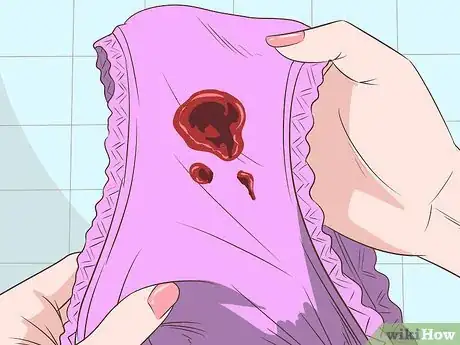



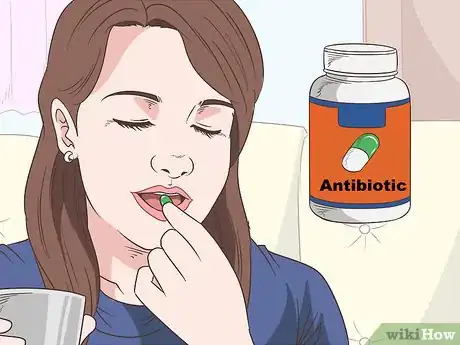
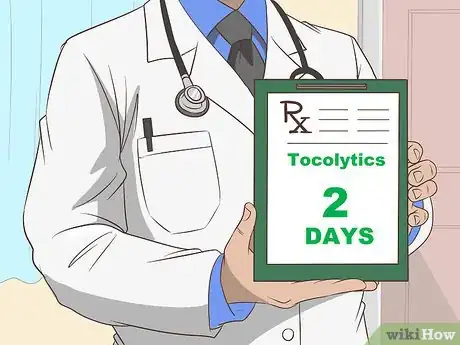
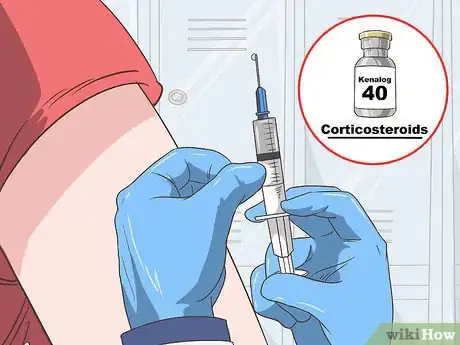
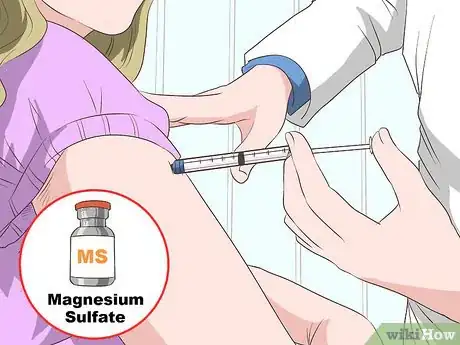



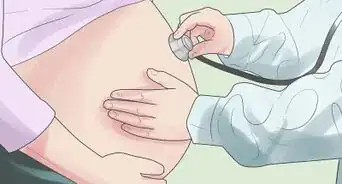




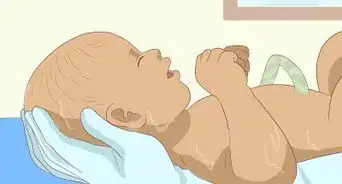














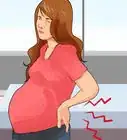


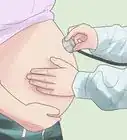



































Medical Disclaimer
The content of this article is not intended to be a substitute for professional medical advice, examination, diagnosis, or treatment. You should always contact your doctor or other qualified healthcare professional before starting, changing, or stopping any kind of health treatment.
Read More...